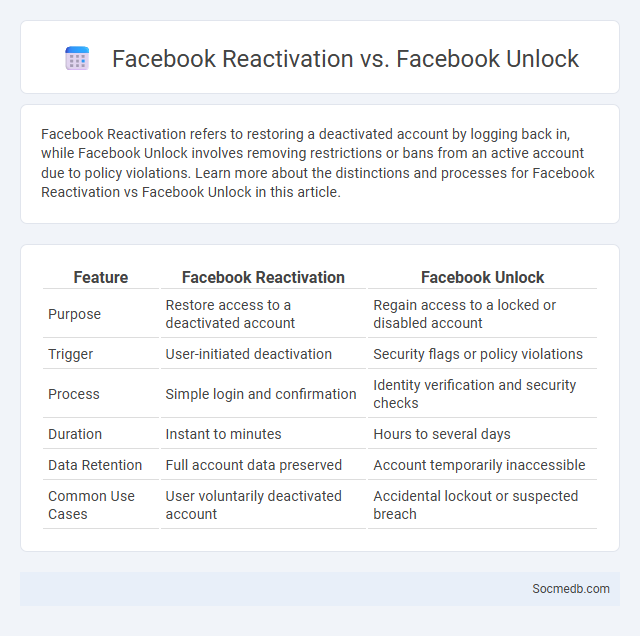
Photo illustration: Facebook Reactivation vs Facebook Unlock
Facebook Reactivation refers to restoring a deactivated account by logging back in, while Facebook Unlock involves removing restrictions or bans from an active account due to policy violations. Learn more about the distinctions and processes for Facebook Reactivation vs Facebook Unlock in this article.
Table of Comparison
| Feature | Facebook Reactivation | Facebook Unlock |
|---|---|---|
| Purpose | Restore access to a deactivated account | Regain access to a locked or disabled account |
| Trigger | User-initiated deactivation | Security flags or policy violations |
| Process | Simple login and confirmation | Identity verification and security checks |
| Duration | Instant to minutes | Hours to several days |
| Data Retention | Full account data preserved | Account temporarily inaccessible |
| Common Use Cases | User voluntarily deactivated account | Accidental lockout or suspected breach |
Understanding Facebook Reactivation
Facebook reactivation allows you to regain access to your account after a period of deactivation, preserving your friends list, photos, and posts. Understanding the process involves knowing that your data remains intact unless you choose permanent deletion, and you can reactivate simply by logging back in with your credentials. Reactivation restores your profile visibility and notifications, enabling seamless reconnection with your social network.
What Does Facebook Unlock Mean?
Facebook Unlock refers to the process of removing restrictions or limitations imposed on a Facebook account, often due to security concerns, policy violations, or suspicious activity. This unlock action enables users to regain full access to their profiles, pages, and features after verifying their identity or resolving issues flagged by Facebook's automated systems. Businesses and individual users benefit from prompt unlocks to maintain continuous engagement and protect their online presence on the platform.
Key Differences Between Reactivation and Unlocking Accounts
Reactivating a social media account involves restoring access to a previously deactivated or deleted profile, allowing users to regain full functionality along with their posts, friends, and previous interactions. Unlocking an account typically addresses temporary restrictions imposed due to security concerns or policy violations, enabling users to regain access without losing data or connections. While reactivation is often user-initiated after voluntary deactivation, unlocking usually requires compliance with platform guidelines or verification steps to lift imposed restrictions.
Common Reasons for Facebook Deactivation
Common reasons for Facebook deactivation include privacy concerns, excessive screen time, and negative social interactions. Users often deactivate their accounts to regain control over personal data or reduce distractions impacting productivity. Understanding these factors can help you make informed decisions about managing your social media presence.
Why Facebook Accounts Get Locked
Facebook accounts get locked primarily due to suspicious activities like multiple failed login attempts, unusual IP addresses, or violating community standards such as posting inappropriate content. Automated security systems trigger account locks to protect user data from potential hacking or unauthorized access. Users must verify their identity through multi-factor authentication or submitting identification documents to regain account access.
Steps to Reactivate Your Facebook Account
To reactivate your Facebook account, log in with your original email or phone number linked to the account and enter your password. Your account will be restored once the login is successful, enabling you to access your profile, friends, and content without losing data. Ensure your app or browser is updated for seamless reactivation and consider updating your security settings to keep your account safe.
How to Unlock a Locked Facebook Account
To unlock a locked Facebook account, start by visiting the Facebook Help Center and using the "Identify Your Account" tool to confirm your identity with a registered email or phone number. Follow the prompts to reset your password by verifying your identity through trusted contacts, government-issued ID, or two-factor authentication methods. If access remains restricted, submit an appeal via Facebook's account recovery form, providing accurate personal information to expedite verification and regain control swiftly.
Security Implications: Reactivation vs Unlock
Understanding the security implications of social media reactivation versus account unlocking is crucial to protecting Your online presence. Reactivating an account often involves using stored credentials and may carry risks of unauthorized access if recovery information is outdated. Unlocking an account typically requires identity verification steps, which can provide a more secure process by ensuring only the rightful owner regains access.
Reactivation Scenarios: When and Why
Reactivation scenarios in social media focus on engaging dormant or inactive users to boost platform activity and user retention. These scenarios often arise during app updates, feature launches, or personalized marketing campaigns that target users based on their past interactions and inactivity duration. Leveraging data analytics and user behavior patterns enables precise timing and content for reactivation efforts, increasing the likelihood of reconnecting users effectively.
Tips to Prevent Future Facebook Lockouts
To prevent future Facebook lockouts, enable two-factor authentication and regularly update your contact information to ensure account recovery options are current. Avoid suspicious links and apps that may trigger security flags, and maintain strong, unique passwords to reduce unauthorized access risks. Monitor login alerts for unfamiliar activity and promptly review Facebook's security settings to stay compliant with platform policies.
 socmedb.com
socmedb.com